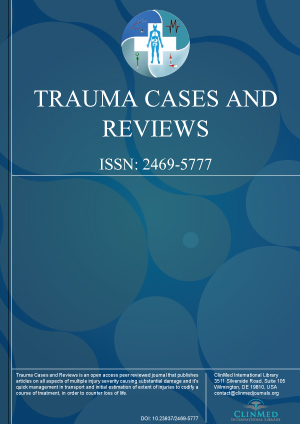Open Access DOI:10.23937/2469-5777/1510035
Acute Compartment Syndrome Following Anterior Cruciate Ligament Reconstruction with Autologous Hamstring Graft
Benjamin Wheatley and Matthew Oetgen
Article Type: Case Report | First Published: April 01, 2016
Compartment syndrome is an extremely rare complication described in association with anterior cruciate ligament (ACL) reconstruction. Previous reports have described this complication as a result of extravasation of fluid into dependent compartments. One proposed mechanism is from a capsular defect that allows irrigation fluid to flow from the joint into lower leg muscular compartments. However, no reports could be found linking the development of compartment syndrome to bleeding from the graft ...
Open Access DOI:10.23937/2469-5777/1510034
Isolated Scaphoid Dislocation
Lasanka De Silva, Lachlan Mc Combie Batty, Neil Fergus Mackay and Jonathan Seymour Mulford
Article Type: Case Report | First Published: March 17, 2016
A 76 year old right hand dominant male retired anaesthetist presented with a painful and swollen right wrist after falling from standing height, landing on the ulnar aspect of his out stretched right hand. The injury was closed and the limb was neurovascularly intact. He had a previous distal radius fracture years ago previously treated non-operatively. Wrist radiographs demonstrated an isolated scaphoid dislocation (Figure 1)....
Open Access DOI:10.23937/2469-5777/1510032
Tibial Plateau in Combination with Diaphyseal Fracture: A Case Study
Ran Atzmon, Zachary Sharfman T, Oded Rabau, Gabriel Agar, Yiftah Beer and Dror Lindner
Article Type: Case Report | First Published: February 09, 2016
Simultaneous tibial plateau and diaphyseal tibial fractures are a rare occurrence and have seldom been reported in the literature. Each fracture requires a different surgical approach, which creates challenges for the operating physician. Tibial plateau fractures require anatomical reduction and restoration of the joint line in order to achieve rigid fixation and immediate mobilization of the joint. Conversely, diaphysis tibial fractures can be treated with relative stability and do not require ...
Open Access DOI:10.23937/2469-5777/1510031
A Case Report of a Rare Complication of an Intrapelvic Migration of the Lag Screw of a Gamma Nail: Review of the Literature
Dimitrios Georgiannos, Vasilios Lampridis and Ilias Bisbinas
Article Type: Case Report | First Published: February 06, 2016
Gamma nail is a safe internal fixation device widely used for treatment of pertrochanteric fractures. Cut out of lag screw has been reported to be the most frequent mechanical complication. Penetration of acetabulum and intrapelvic migration of the lag screw of the gamma nail is an extremely rare complication. We report two cases of medial migration and penetration of the medial wall of acetabulum by the lag screw of a gamma nail and a comprehensive review of the literature....
Open Access DOI:10.23937/2469-5777/1510030
A Peculiar Case
Raoul van Vugt and Peters J
Article Type: Clinical Image | First Published: February 06, 2016
A 65-year-old male with a history of an oligodendroglioma (for which debulking surgery in 2012) was presented in our emergency department by ambulance paramedics after he had fallen in his kitchen. Initial examinations revealed an awake, hemodynamically normal patient with a knife penetrating the medial side of his face, just below the right eyeball. Looking at the depth and position of the knife, the assessment was that it was a sharp, pointed knife that went in with a lot of force....
Open Access DOI:10.23937/2469-5777/1510028
Radial Head Fractures Treated with Open Reduction and Internal Fixation
Moghaddam A, Raven TF, Kaghazian P, Studier-Fischer S, Swing T, Grutzner PA and Biglari B
Article Type: Research Article | First Published: January 21, 2016
Radial head fractures are responsible for 2 to 5% of adult fractures. Especially problematic is the treatment of dislocated and unstable fractures which often have a worst prognosis. The purpose of this study was to evaluate the results of open reduction and internal fixation (ORIF) in the treatment of radial head fractures....
Open Access DOI:10.23937/2469-5777/1510027
Missed Spinal Lesions in Traumatized Patients
Ana M Cervan de la Haba, Miguel Rodriguez Solera J, Miguel S Hirschfeld Leon and Enrique Guerado Parra
Article Type: Case series | First Published: January 15, 2016
Overlooked spinal injuries and delayed diagnosis are still common in traumatized patients. The management of trauma patients is one of the most important challenges for the specialist in trauma. Proper training and early suspicion of this lesion are of overwhelming importance. The damage control orthopaedics, diagnosis and treatment algorithm applied to multitrauma patients reduces both morbidity and mortality in polytrauma patients due to missed lesions....
Open Access DOI:10.23937/2469-5777/1510026
Association between Sequential Organ Failure Assessment Score and In-hospital Deaths of Surgical, Critically Ill Patients with Sepsis
Noboru Harada, Ken Shirabe, Shinji Itoh, Hideaki Uchiyama, Motoyuki Yamagata, Fumiaki Kishihara, Takashi Maeda, Nao Kinjo, Kensaku Sanefuji, Yosuke Kuroda, Kazutoyo Morita, Tomoharu Yoshizumi, Toru Ikegami, Yo-ichi Yamashita, Yoshihiko Maehara and Study group of refractory disease in hepato-pancreato-biliary surgery
Article Type: Original Article | First Published: January 13, 2016
Sepsis, defined as infection-induced systemic inflammatory response syndrome (SIRS), is the leading cause of death in non-cardiac critically ill patients. In the United States, nearly 200,000 deaths per year are attributed to sepsis. Worldwide, as many as 20 million people may experience sepsis annually, with a mortality rate of about 35%. Sepsis involves multiple mechanisms, including the release of cytokines and the activation of the complement, coagulation and fibrinolytic systems....
Open Access DOI:10.23937/2469-5777/1510024
Liver Injury Associated with Chest Compression in Cardiopulmonary Arrest Patients
Takeshi Nishimura, Ayana Okamoto, Noritomo Fujisaki, Yoshiyuki Orihara, Ten Saita, Kunihiro Shirai, Isamu Yamada, Atsunori Nakao and Joji Kotani
Article Type: Review Article | First Published: January 12, 2016
We reviewed and summarized fifteen cases associated with liver injury following chest compression for CPA reported in Japan. In some cases, cardiopulmonary resuscitation (CPR) was administered by medical assistants such as doctors or medical technicians, but in other cases, CPR was given by bystanders. Five patients were male and eight were female, with ages ranging from 31 to 83 years old. Unfractionated heparin was administered to ten patients as a treatment for embolism or indication of veno-...

